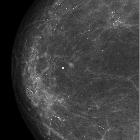inflammatory breast cancer
Inflammatory carcinoma of the breast, also referred to as inflammatory breast cancer, is a relatively uncommon but aggressive form of invasive breast carcinoma with a characteristic clinical presentation and unique radiographic appearances.
Epidemiology
Inflammatory carcinomas account for 1-4% of all breast cancers, typically occurring in women between the 4 to 5 decades .
Clinical presentation
Clinically, inflammatory breast cancer mimics mastitis. The breast is enlarged (often of relatively short onset), indurated, erythematous, warm, and may be tender and painful. The skin is thickened and edematous, classically with a "peau d’orange" appearance. There may or may not be an underlying palpable mass.
The condition may also present with flattening, erythema, crusting, blistering, or retraction of the nipple. Fixed palpable ipsilateral axillary lymph nodes, synonymous with metastatic disease, are frequently observed.
However systemic symptoms such as fever are absent which helps somewhat differentiate from mastitis. Axillary lymphadenopathy (often fixed and palpable) may be present in ~50% of cases at presentation .
Pathology
While any subtype of primary breast carcinoma may be present, invasive ductal carcinoma tends to be the most prevalent histological type .
Histologically, the dermal lymphatic invasion is pathognomonic of inflammatory breast cancer but does not necessarily need to be demonstrated to make the diagnosis . The presence of tumorous cells in dilated lymphatics may be present in ~80% of cases .
Staging
Inflammatory breast cancer is a T4 tumor according to the standard TNM staging classification of breast cancer.
Radiographic features
Mammography
Mammographic findings include tumor mass and malignant microcalcifications. More specifically, inflammatory changes such as extensive skin and trabecular thickening/coarsening, and/or diffusely increased breast density are important clues that should lead the radiologist to suggest the diagnosis.
Ultrasound
Ultrasound may be helpful to locate a hypoechoic shadowing mass, which can be obscured on mammography by diffusely increased breast density. Ultrasound may also show skin thickening (the most common and obvious finding on ultrasound), pectoral muscle invasion and axillary involvement. Ultrasound is often used to assess for areas of focal change as well as to determine a suitable site for biopsy.
MRI
According to one study, the most common MRI finding is a mass or multiple masses (73%) . Masses are frequently multiple, small, and confluent; mass margins, irregular; and internal enhancement pattern, heterogeneous. MRI also demonstrates evidence of skin thickening in a vast majority of cases.
Treatment and prognosis
In cases where an image-guided biopsy of the underlying intraparenchymal mass or axillary lymph nodes does not give the diagnosis, a skin biopsy may be indicated . Inflammatory breast cancer has a tendency to metastasize at an early stage .
Unlike other types of breast cancer in which surgery is the first modality of treatment, chemotherapy before surgery or radiation therapy is the current standard treatment.
Differential diagnosis
- infective mastitis
- painful breast with prominent erythematous changes and fevers
- locally advanced invasive breast carcinoma
- usually, a long-term presentation that has been neglected
- lymphomatous involvement of the breast
- other causes of breast edema
- related to venous (e.g. SVC syndrome) or lymphatic obstruction (e.g. previous axillary emptying)
Siehe auch:
und weiter:

 Assoziationen und Differentialdiagnosen zu inflammatorisches Mammakarzinom:
Assoziationen und Differentialdiagnosen zu inflammatorisches Mammakarzinom:

